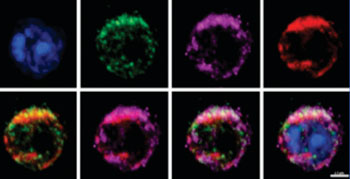Recently Identified Protein Stimulates Expansion of Protective T-cell Population
By LabMedica International staff writers
Posted on 29 Apr 2015
A team of British cancer researchers has identified a protein that helps the immune system ward off cancer by promoting the rapid expansion of the population of protective CD8+ T-cells.Posted on 29 Apr 2015
Protective CD8+ T cell–mediated immunity requires a massive expansion in cell number and the development of long-lived memory cells. However, in cases of advanced cancer, these types of cells are often unable to proliferate in large enough numbers to fight the disease.

Image: Cytotoxic T-cells stained to show the LEM protein (Photo courtesy of Imperial College London).
Investigators at Imperial College London (United Kingdom) reported in the April 16, 2015, online edition of the journal Science that they had identified and isolated a protein from a line of mutant, cancer resistant mice. The protein, which they called Lymphocyte Expansion Molecule (LEM), promoted antigen-dependent CD8+ T-cell proliferation, effector function, and memory cell generation in response to infection with lymphocytic choriomeningitis virus.
At the molecular level LEM was found to control the levels of oxidative phosphorylation (OXPHOS) complexes and respiration resulting in the production of pro-proliferative mitochondrial Reactive Oxygen Species (mROS). This was accomplished through LEM's interaction with CR6 interacting factor (CRIF1). Thus, LEM provided a link between immune activation and the expansion of protective CD8+ T-cells driven by OXPHOS and represented a pathway for the restoration of long-term protective immunity. These results were confirmed by experiments performed with mice that had been genetically engineered to lack the LEM gene.
Senior author Dr. Philip Ashton-Rickardt, professor of immunobiology at Imperial College London, said, "Cancer cells have ways to suppress T-cell activity, helping them to escape the immune system. Genetically engineering T-cells to augment their ability to fight cancer has been a goal for some time and techniques for modifying them already exist. By introducing an active version of the LEM gene into the T-cells of cancer patients, we hope we can provide a robust treatment for patients. Next we will test the therapy in mice, make sure it is safe and see if it can be combined with other therapies. If all goes well, we hope to be ready to carry out human trials in about three years."
Related Links:
Imperial College London








 (3) (1).png)




